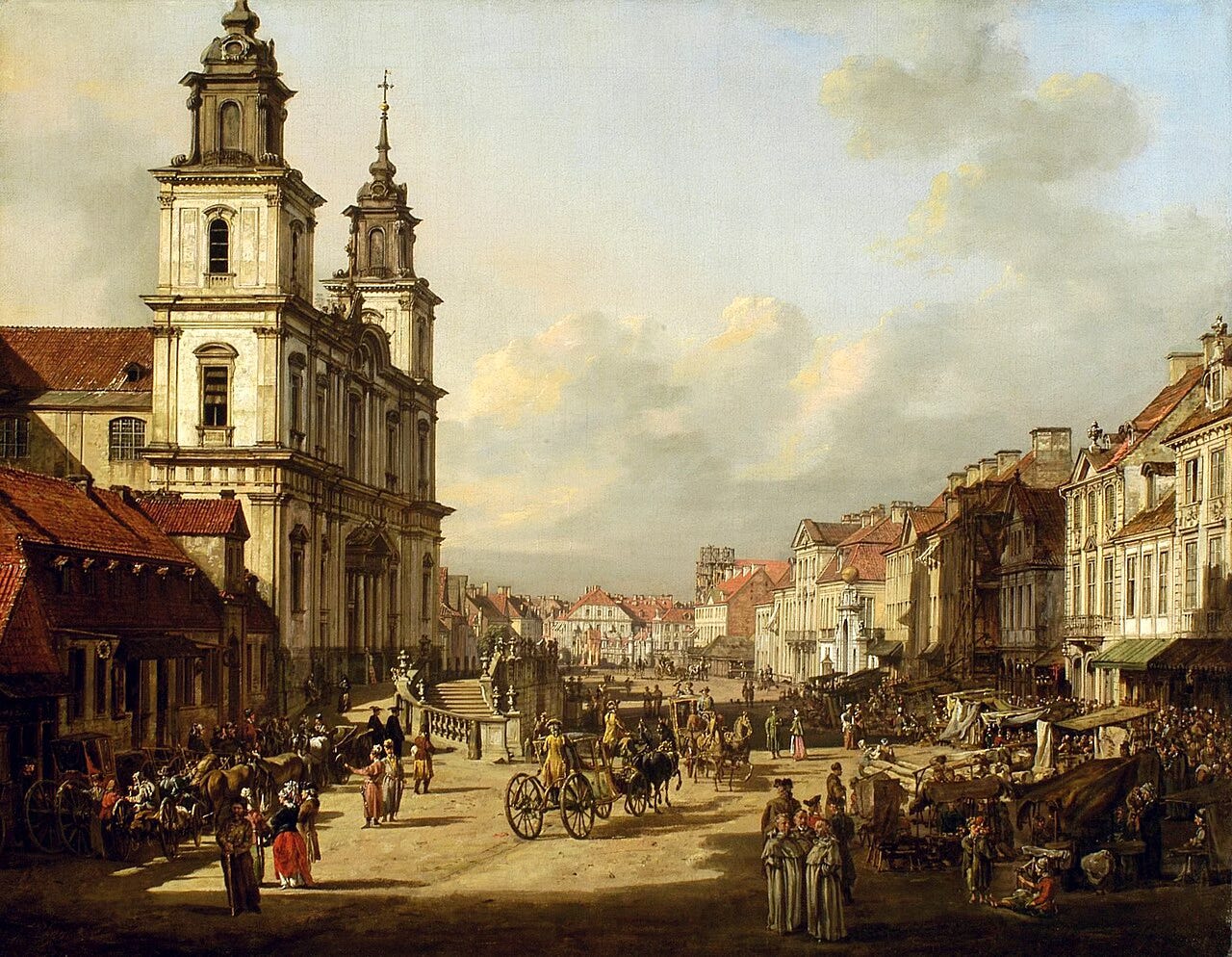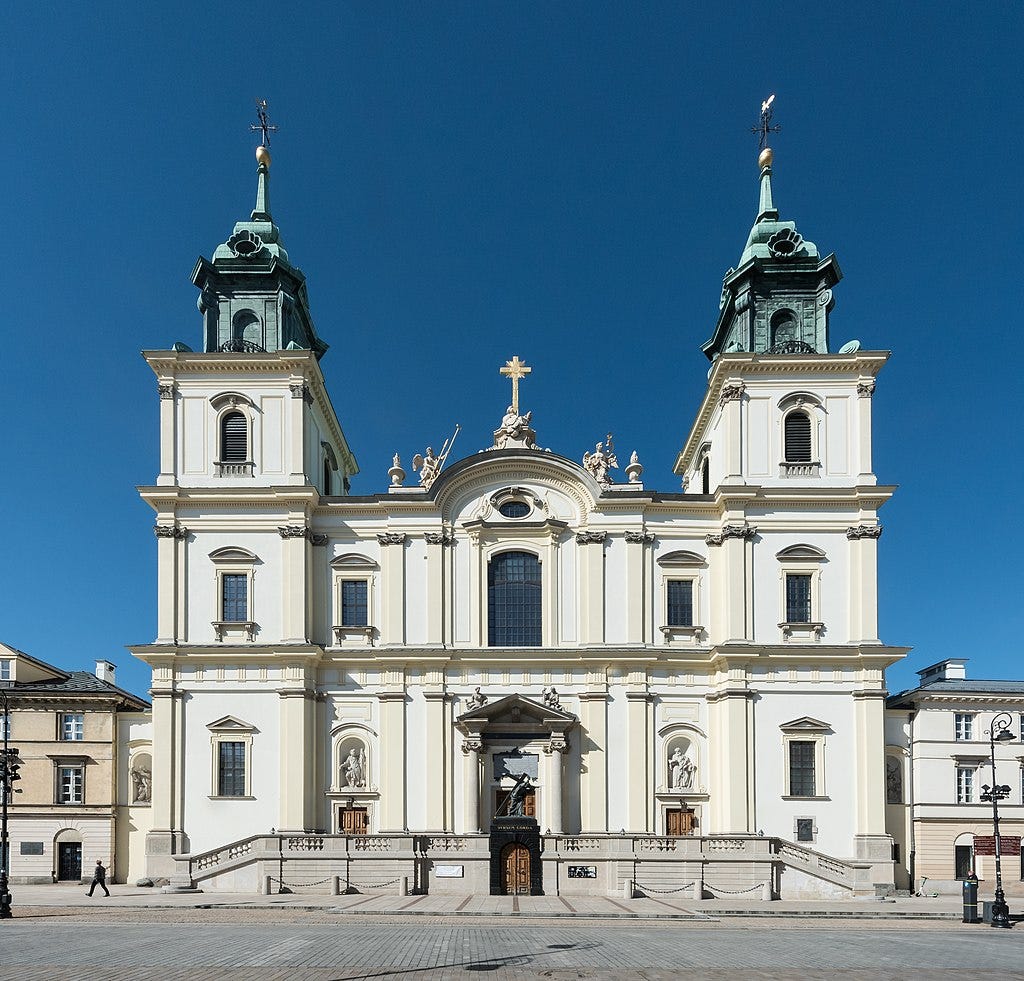The Canaletto Room and the Reconstruction of Warsaw
It is easy to find yourself overwhelmed in the Royal Castle in Warsaw, with its richly delicate halls and colorful rooms full of neoclassical allusions to old pagan gods and Roman political figures. That is especially true if you’re not used to running on less than six hours of sleep, like I am. And yet, despite my fatigue, I thirstily soaked up everything — every painting, every statue, even every floor tile. Even though each room had something incredible to offer, there was one room in particular that caught my attention.
Pokój Canaletta — the Canaletto Room. Other than a few benches along the walls, the floor is free from all furniture and objects. Visitors are free to traverse across the patterned brown floors without running into anything besides the other guests. But it would be wrong to call the room empty. Soft, oil landscape paintings enclosed in gold frames cover the walls from floor to ceiling, each as detailed a snapshot as if it were taken by an actual camera. Each one bears the mark of the Italian artist, Bernardo Bellotto, who borrowed the surname of his illustrious uncle, Giovanni Canaletto, during his time in Central Europe.
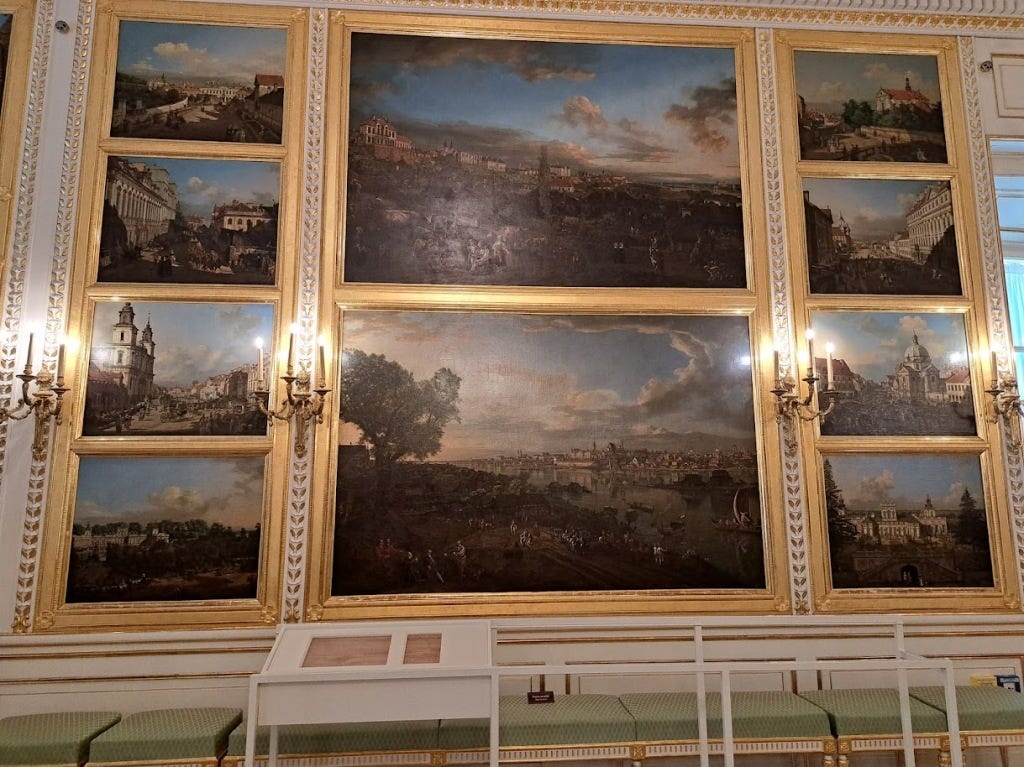
Why does a reconstructed Polish castle so proudly display over a dozen paintings by an Italian artist in a room specifically dedicated to his works alone? The simple answer is that they were created with the walls of the Royal Castle in mind. In this sense, it’s just a matter of accurately representing the historic castle; each painting had an intended home there before it was even made. After all, Bernardo Canaletto spent the last thirteen years as the court artist of the last king of Poland, Stanisław Augustus Poniatowski.
Still, while this answer is definitely true, I believe that there’s a little more to it. The beauty and detail of each picture in this extraordinary room transports the viewer into the past with a snapshot depiction of Varsovian history. Even more incredibly, that same viewer can then leave the palace and find that same level of beauty and detail in the surrounding historic old town — thanks in large part to these paintings. Despite their Italian origins, the works of the Canaletto Room have in fact been an essential key to the preservation and reconstruction of Polish cultural identity.
You might have already noticed that I refer to the Royal Castle in Warsaw as “reconstructed” castle. Well, that’s because the historic architecture is deceiving. The Royal Castle that currently graces Warsaw’s Old Town Square is only about four or five decades old. The original palace was bombarded and looted by the German army in the initial months of World War II. By the end of the war in 1945, it, along with 85% of the surrounding city, was little more than a pile of rubble.
Thankfully, Canaletto’s detailed paintings did not share the fate of their museum castle and most other historic Varsovian landmarks. They were transferred to the National Museum of Warsaw in the early days of the war, as the Royal Castle was a likely bombing target. From there, they were taken to Krakow (the capital of the area of occupied Polish territory, which the Nazis dubbed the “General Government”). As the war continued, the paintings ended up in Germany for “safekeeping”, along with other works considered worthy of preservation by the Nazis (though this collection only consisted of art deemed to have non-Polish origins by Nazi pseudo-scientists and historians). The Canaletto paintings ended up in Callenberg Castle in southeast Germany, where they and other remarkable works of art were discovered by the American Art Protection Service, popularly known as the “Monuments Men”.
The Poles are a resilient people, proud of their history and culture. Soon after the end of the war, the Polish government reclaimed the Canaletto paintings along with other stolen works. A campaign to rebuild the city sprang up, and the palace itself was proclaimed a great monument of Polish history and culture by the senate. Fundraisers were set up within Poland and abroad to raise money for the grand project.
And what did they use for the blueprints to reconstruct the buildings that now grace Warsaw’s Old Town? Bellotto-Caneletto’s large, detailed landscapes (known as vedute) … at least partially. The present old townscape is not a perfect one-for-one reproduction of the paintings, of course; it would have been a nearly impossible feat to reconstruct every single building. But the important cultural icons? They are pretty darn close to their original drawings.
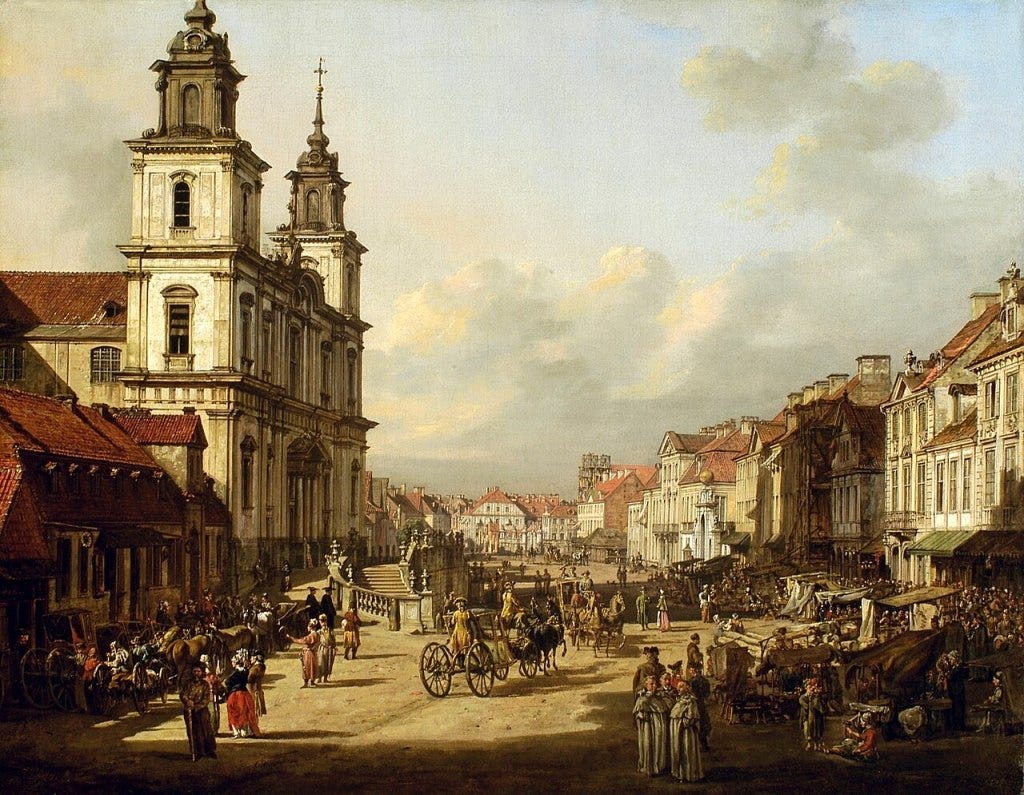
One prime example is the Holy Cross Church, which stands just a mile away from the Royal Castle. Canaletto took no shortcuts in depicting this lively scene. Every single shingle on the rooftop can be distinguished — even on the buildings in the background. Dozens of people flood the streets, each dressed appropriately to reflect their occupation, and each conducting whatever business brought them to this particular street in the first place.
It is the church itself, however, that is the focal point of this painting. The Church of the Holy Cross was first completed in the 1750s, a mere two decades before Canelletto replicated it in all its glorious detail. While most of the dynamic action is confined to the bottom half of the canvas, the church makes use of the entire vertical axis of the painting, reaching its double steeples into the sunlight, in contrast to the sea-like waves of white-gray clouds directly opposite the building.
Again, despite the two-dimensional nature of the painting, the various textures of the church render the piece immersive — as in the copper roof, the bell towers, and the church walls. The columns on the church’s front facade and the intricate window trims show their varying levels of depth. Even the statues on top of the main facade are properly depicted (though their identities cannot be determined due to the scene’s angle).
Like the Royal Castle, the Church of the Holy Cross was badly damaged during World War II and was rebuilt early in the reconstruction project. The main portion of the building was completed by 1953 — a mere eight years after the war — and now stands as a beautiful memorial of Polish historical and cultural identity (as well as the resting place of pianist Frederic Chopin’s heart). The new church is almost identical to the building in Canaletto’s painting, save for the oxidized green color of the current copper roof, which makes the building appear older than it actually is. Perhaps those who remembered it from before the war had the color changed for the sake of nostalgia for their familiar church.
So how did the Italian artist manage to create such beautifully detailed and accurate paintings of the Polish capital? Like his uncle (the more famous Canaletto), Bellotto-Canaletto is believed to have used a method known as camera obscura. The camera obscura, or pinhole camera, works when light passes through a pinhole or small lens into a darkened room or box. It then projects an image of the real world onto a wall, screen, or canvas. From there, an artist like Canaletto can trace the projection with a pencil and use the drawing as the basis of his vedute. This technique may have allowed him to include every detail — every window frame, roof shingle, chimney, column, or step — he desired. Though Canaletto, like every artist, did take some liberties with his work, his detailed paintings thus depicted a fairly accurate picture of Warsaw in his time.
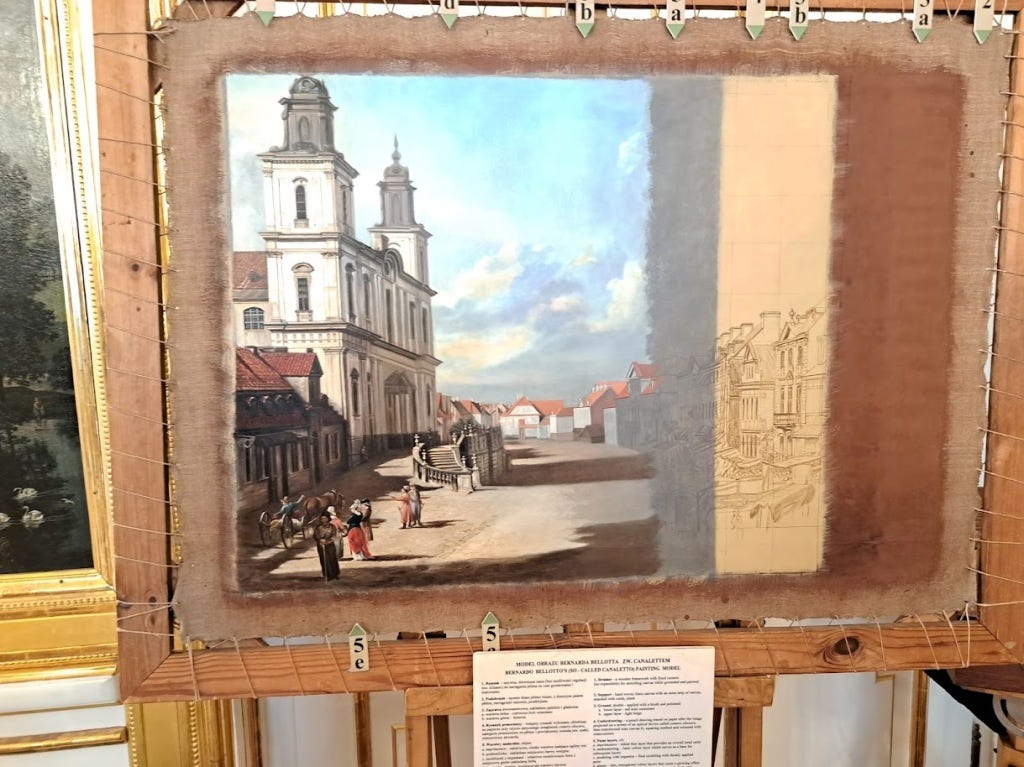
And it was Canaletto’s great attention to detail that saved the Church of the Holy Cross, the Royal Castle of Warsaw, and many other historic elements of Warsaw’s Old Town.
Today, the reconstructed Historic Center of Warsaw is among UNESCO’s World Heritage Sites. As it should be! The beauty of Poland’s historic old towns is only increased by the fact that so many of them were rebuilt almost from scratch in the aftermath of World War II. It is almost a miraculous feat.
Visiting Warsaw now, I love how all the pieces have come together so that I can walk amid the same buildings that old Polish kings and queens once did. I appreciate the detail that Canaletto put into his Polish vedute. I am so grateful that the Canaletto paintings made it through the war unscathed. I love how these richly decorated paintings were used as guides for rebuilding the city. I love how the Polish people leapt headfirst into the historical rebuilding project the minute the war ended, when it would have been so much easier to cover the entire city in communist-style apartment bloks as the Cold War loomed over them. I love how they prioritized and recollected their historical and cultural heritage, which both the Nazis and Soviets had tried so hard to destroy. And I love that I get to walk along Warsaw’s reconstructed streets and come to stand in front of the paintings that made the project possible. I love this city. I can’t wait until my next visit.



